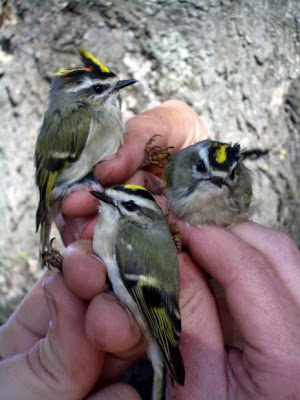 Late season 2009 songbird crew, from left: Heidi, Jay, Caroline (sweet hat!),
Late season 2009 songbird crew, from left: Heidi, Jay, Caroline (sweet hat!), Nathan, and Stephanie
(we also had help from Jack & Rob earlier in the season and Gary, Erin, Micah, Randy, Dave, & Carol throughout)
In all, we captured 5,748 birds of 61 species in 2009; this marks the 5th highest season total and capture rate (5,748 birds in 4,364 mist net hours = 1.317 birds per mist net hour) in the 13 seasons so far. Thus, 2009 was a little above average ... which is still really good, especially in comparison with most other banding stations I know of that have significantly lower capture rates.
The top ten:
- Dark-eyed Junco 799 (includes a single-day record 170 juncos on 10-10)
- Western Tanager 697 (new season record)
- Ruby-crowned Kinglet 638 (lowest season-total to date)
- White-crowned Sparrow 495
- Dusky Flycatcher 322
- Spotted Towhee 285 (2nd highest season total)
- MacGillivray's Warbler 283
- Yellow-rumped Warbler 226
- Nashville Warbler 195
- Yellow Warbler 192
We set or tied season records for a number of species in 2009, including Western Tanager (n=697), Cassin's Vireo (131), Lazuli Bunting (91), Swainson's Thrush (45 - 19 better than the previous high of 26!!), 'Western' Flycatcher (22 - a tie with 2006), Black-chinned Hummingbird (16), Song Sparrow (9), and Savannah Sparrow (4). Also, though we hardly captured any compared to the # that was around, we had an amazing late fall for American Robins - hundreds were around the site for a couple weeks straight and the hawkwatchers estimated over 2,250 robins flying past on one day!
Notably absent again was Northern Pygmy-owl which we had captured at least one per season for the first 11 years and then none in 2008 or 2009 after a record season in 2007 (???). Also, though I don't see any reason for concern for most of the species that we catch (based on the raw numbers anyway; still awaiting a more rigorous analysis of population trends) and most species numbers are either stable (with some cyclic and/or inter-annual variation) or increasing, my concern for the status of Golden-crowned Kinglets continues to grow.
Though we detected this species by their high-pitched call notes most days in September and October, we captured/banded only 11 in 2009 and this is the lowest season total yet. It could be that shifts in their feeding (i.e., maybe concentrating their feeding in the Douglas-fir trees even more than usual) could be driving this pattern but we captured at least 60 individuals from 1997-2001 and numbers have generally been much lower since (see the below Excel graph to get a sense of the trend in annual captures for GC Kinglets):
 In contrast, the following Excel graph shows the annual capture rate for all songbirds combined during the same period:
In contrast, the following Excel graph shows the annual capture rate for all songbirds combined during the same period: As you can see, the combined total for the songbird community as a whole paints a positive picture - stable if not slightly increasing. Thus, why the apparent decrease in Golden-crowned Kinglets?? Something to look into ....
As you can see, the combined total for the songbird community as a whole paints a positive picture - stable if not slightly increasing. Thus, why the apparent decrease in Golden-crowned Kinglets?? Something to look into ....I'll post again with the final raptors #s and/or if something unusual shows up.
Cheers,
Jay




















